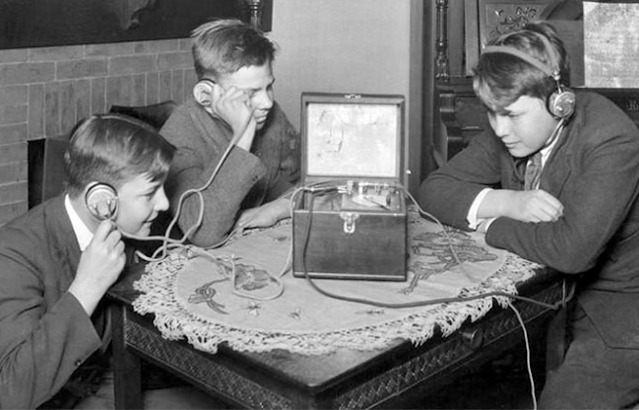© Mark Ollig
In 1922, the US population was about 110 million people.
Today, 100 years later, it is around 330 million.
Those living in 1922 anticipated a bright future, as the US economy was booming, and the nation’s wealth began an unprecedented acceleration.
The 1920s were called the Roaring Twenties until 1929, and the crash on Wall Street.
In 1922, approximately 14 million telephones were being used in the US.
Those phones observed one minute of silence Aug. 4, 1922, to honor Alexander Graham Bell, who passed away at age 75.
The British Broadcasting Company, better known as the BBC, began its radio operations 100 years ago in 1922, out of its London studio owned by wireless radio pioneer Guglielmo Marconi.
Two years earlier, KDKA out of Pittsburgh, PA, became the first commercial radio station to begin transmitting its amplitude modulated over-the-air signal on 1020 kHz.
People in Pittsburgh purchased “Amateur Wireless Sets,” or ready-to-use radio receiver boxes with wired headphones from the Joseph Horne department store in Pittsburgh to listen to the local KDKA radio station broadcast.
Live election results of the Harding-Cox US presidential election were broadcast over KDKA Nov. 2, 1920. It was a significant event, as people learned the results from the radio broadcast before the newspapers went to press.
The election-night radio broadcast originated inside a small shack atop one of the Westinghouse Electric buildings in East Pittsburgh.
In this historic first-of-its-kind live radio broadcast to the public of the US presidential voting results, four people were in the studio that night: engineer William Thomas; telephone line operator John Frazier; R.S. McClelland; a standby, and the first radio announcer, Leo Rosenberg.
At the start of the radio broadcast 102 years ago, Leo Rosenberg said, “This is KDKA of the Westinghouse Electric and Manufacturing Company in East Pittsburgh, Pennsylvania. We shall now broadcast the election returns. We are receiving these returns through the cooperation and by special arrangement with the Pittsburgh Post and Sun. We’d appreciate it if anyone hearing this broadcast would communicate with us, as we are very anxious to know how far the broadcast is reaching and how it is being received.”
I learned the word “broadcasting” is credited to Frank Conrad, an engineer with the Westinghouse Electric Company in Pittsburgh.
He was immersed in new technology and built an experimental radio transmitter on the second floor of his garage in Wilkinsburg, PA.
Conrad used broadcasting to describe radio transmissions as analogous with the agricultural term, broadcast seeding, meaning spreading seeds far and wide.
So, it made sense to call radio’s transmission “voice broadcasting” to the people far and wide.
A Detroit radio station aired the first regularly-scheduled news program 100 years ago.
In 1922, “The Detroit News Radiophone” station WWJ, owned by The Detroit News newspaper, began a nightly news broadcast running from 8 to 10 p.m.
With commercial electricity becoming available to more homes and businesses during the 1920s, the importance of radio broadcasting to the public began to be realized.
During 1922, the folks in the US spent $60 million ($992.6 million in 2022 dollars) purchasing thousands of radios for listening to some 500 licensed radio stations.
By the mid to late 1920s, 700 radio stations, including NBC Radio, beginning in 1926, and CBS radio, in 1928, had coverage throughout much of the US.
Radio was now competing with the printed pages of the local newspaper to provide the public with news and information.
The late 1920s witnessed nationwide radio networks being heard all across the country, and the birth of radio becoming part of the “mass media” began.
Radio experimenter Reginald Fessenden reportedly transmitted the first radio program of him speaking, music playing from a phonograph, and a violin solo over radio waves Dec. 24, 1906, from Brant Rock, MA (just south of Boston).
He made the hour-long evening talk and music broadcast to any radio amateurs who might be listening.
Fessenden reportedly transmitted audible speech over magnetic radio waves Dec. 23, 1906, using a spark-gap transmitter. His words heard and understood one mile away on a wireless radio receiver were, “One, two, three, four, is it snowing where you are, Mr. Thiessen? If it is, would you telegraph back to me?”
The state archives of North Carolina hold an extensive collection of papers from Reginald Aubrey Fessenden at https://bit.ly/3eT5ZU1.
Reginald Aubrey Fessenden was born Oct. 6, 1866, and passed away July 22, 1932.
US automobiles produced in 1922 include the Bay State six-cylinder models manufactured in Framingham, MA, by a company founded by Richard H. Long, called R.H. Long Motors Company.
In 1922, R. H. Long Motors Company listed the Bay State Coupe at $2,400, the Bay State Sedan was $2,500.
The 1922 Bay State Touring automobile sold for $1,800, equivalent to $29,780 in 2022.
I hope everyone has a safe and prosperous 2022.
Welcome to the new Roaring Twenties of the 21st century.
